

Complexity Theory: A short film.
Beyond the Blueprint. A GENETIC WEB: Interacting species, such as this Gulf fritillary butterfly (Agraulis vanillae) feeding on goldenrod blooms at the edge of a salt marsh on St.
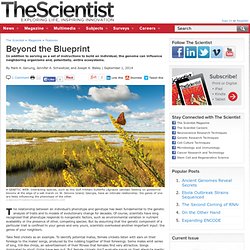
Simons Island, Georgia, have an intimate relationship: the genes of one are likely influencing the phenotype of the other.© BEACHCOTTAGEPHOTOGRAPHY/ISTOCKPHOTO.COM The relationship between an individual’s phenotype and genotype has been fundamental to the genetic analysis of traits and to models of evolutionary change for decades. Of course, scientists have long recognized that phenotype responds to nongenetic factors, such as environmental variation in nutrient availability or the presence of other, competing species. But by assuming that the genetic component of a particular trait is confined to your genes and only yours, scientists overlooked another important input: the genes of your neighbors.
Complexity Researchers Help Visualize the Spread of Western Thought. Don't Cut Through Complexity: Understand it and Manage It (Sorry, KPMG) » Complexity KPMG has the tagline “Cutting through Complexity” which suggests they really don’t understand complexity at all.
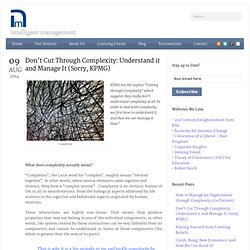
In order to deal with complexity, we first have to understand it, and then we can manage it. How? What does complexity actually mean? “Complexus”, the Latin word for “complex”, roughly means “twisted together”. These interactions are highly non-linear. Awesome Animations. Petersen Graph Creator: John McCabe-Dansted Supervisor: Jamie Simpson (Curtin)Type: Remote site Description: This graph is one of the graphs most commonly used by mathematicians as an example of various properties.
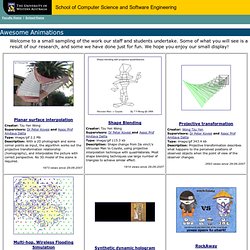
This program finds ways of displaying the graph by placing the points at random locations and refining the graph by pushing points away from each other and pulling connected points closer together. The Wikipedia article describes a Petersen Graph. Introduction — ComplexNetworkSim v0.1.2 documentation. A more technical introduction to the project The framework can can create a virtual complex network with virtual agents that can interact with each other.
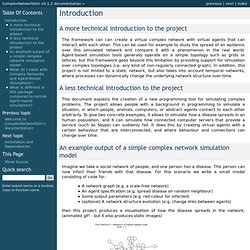
This can be used for example to study the spread of an epidemic over this simulated network and compare it with a phenomenon in the real world. Agent-based simulation tools generally operate on a simple topology such as grids or lattices, but this framework goes beyond this limitation by providing support for simulation over complex topologies (i.e. any kind of non-regularly connected graph). In addition, this project is not limited to a static network, but also takes into account temporal networks, where processes can dynamically change the underlying network structure over time. A less technical introduction to the project This document explains the creation of a new programming tool for simulating complex problems.
An example output of a simple complex network simulation model. World Renowned Heart Surgeon Speaks Out On What Really Causes Heart Disease. We physicians with all our training, knowledge and authority often acquire a rather large ego that tends to make it difficult to admit we are wrong.

Crowd Control. MOTION CONTROL: An immense flock of starlings, known as a murmuration, preparing to roost at dusk© FIONA ELISABETH EXON/GETTY IMAGES Small silvery schooling fish known as golden shiners are experts at quickly finding shady spots that offer better camouflage from predators.
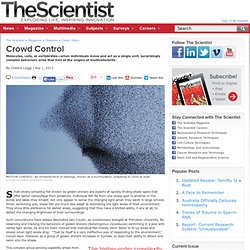
Individual fish flit from one shady spot to another in the ponds and lakes they inhabit, but only appear to sense the changing light when they swim in large schools. ShiftN.com : clarity in complexity. The Empire Didn’t Strike Back… The Demise of FuturICT. Posted by gregfisher on Jan 22nd, 2013 in Blog , Social | 6 comments By Greg Fisher Last week the European Commission chose not to invest in FuturICT, which was a massively ambitious project to integrate ICT and complexity science.
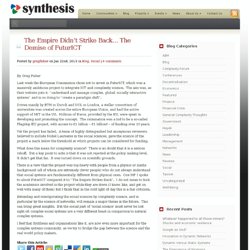
The aim was, as their website puts it, “understand and manage complex, global, socially interactive systems” and in so doing to “create a paradigm shift”. Accelerating science. "The Power of Networks" +The Importance of Polymaths - Beautifully Visualized by RSA. A visual exploration on mapping complex networks. The book. The Functional Art is an introduction to Information Graphics and Visualization, the communication of facts and data by means of charts, graphs, maps, and diagrams.
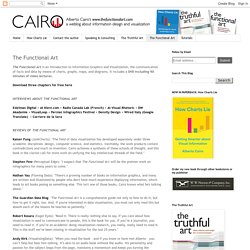
It includes a DVD including 90 minutes of video lectures. Download three chapters for free here Edelman Digital • At Klevr.com • Radio Canada Lab (French) • At Visual Rhetoric • DW Akademie • VisualLoop • Persian Infographics Festival • Density Design • Wired Italy (Google Translate) • Corriere de la Sera. Complex Diagrams. Complexity Timeline. Global internet slows after 'biggest attack in history' 27 March 2013Last updated at 13:03 GMT By Dave Lee Technology reporter, BBC News The BBC's Rory Cellan-Jones explains why the attack is like a "motorway jam", alongside expert David Emm from Kaspersky Lab The internet around the world has been slowed down in what security experts are describing as the biggest cyber-attack of its kind in history.

A row between a spam-fighting group and hosting firm has sparked retaliation attacks affecting the wider internet. Experts worry that the row could escalate to affect banking and email systems. Five national cyber-police-forces are investigating the attacks. Consciousness, group consciousness, mind. Complex Systems. The Interaction of Complexity and Management - Michael Lissack. What is complexity science?

What is management? And how are the two linked? The potential of complexity science in the fields of management and organization studies has been explored before, yet there is little agreement on what complexity science truly is. Lissack and Rivkin, along with a panel of distinguished academics and executives, identify critical topics in the study of complexity science. They reveal complexity science to be a process, one seeking and understanding of the systems we inhabit, and ways of applying that understanding to the management of organizations. Human Systems Dynamics Institute. The following free articles are available to view and download: A Brief Introduction to Complexity This paper by Glenda Eoyang, Ph.D. presents a brief introduction to some of the applications of chaos science to organizational development and behavior.
A Tale of Two Counties This paper was presented by Glenda Eoyang, and Lois Yellowthunder, Ph.D., at the Complexity, Science and Society Conference in Liverpool, England, in October, 2005. From Trees to Webs: Transformation is About Changing How We think. I have been sitting in front of the computer for weeks and weeks now trying to get my thoughts down. How do I introduce my work on transformation? How do I communicate my motivation to change education for the better... to a more equitable system that gets quality work accomplished? And I realized it's difficult to begin talking about my work or any transformation efforts without understanding underlying root causes of problems or even of successes. Then, I happened upon this video from the wonderful folks at RSA Animate, The Power of Networks with Manuel Lima. The video discusses how modern science mirrors our knowledge of how systems work. E:CO Issue Contents. Complexity map_2013.
Search. Bifurcations. Bifurcations Another finding of chaos theory is bifurcation theory . CxConferences.